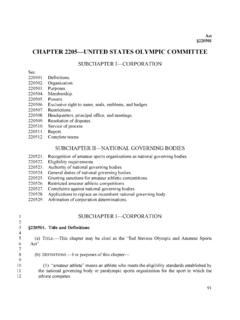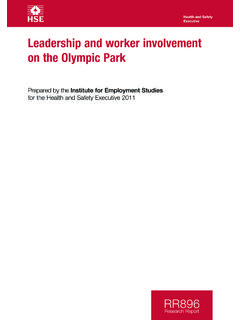Transcription of Environmental achievements of the Sydney 2000 Olympic ...
1 The Environmental GamesEnvironmental achievements of the Sydney 2000 Olympic GamesThe Environmental GamesEnvironmental achievements of the Sydney 2000 Olympic GamesContentsPage 4 Setting a new standard for a new millenniumPage 5 Environment: the third pillar of OlympismPage 6 Sydney s commitment Page 7 Building the stage 8 Venues 13 From wasteland to wetlands15 BiodiversityPage 17 Putting on the show 17 Transport19 WastePage 21 A team effortPage 24 The legacyPage 25 Summary of Environmental achievementsPage 26 Environment sponsors and green groups4We are pleased to introduce the Sydney 2000 publication, The Environmental games .
2 It describes the significant achieve-ments made by Sydney 2000 in delivering a new standard of Environmental excellence for organising andstaging the Olympic and Paralympic games . The goal is to leave a legacy of improved environmen-tal standards for the third was the first host city to include a comprehensive commitment to the environment as part of its bid tohost the Olympic and Paralympic games . Environmental considerations were integrated into all aspects of plan-ning and staging of the Sydney 2000 games , including design, clean up, monitoring, land management, construc-tion, operation of venues, transport, catering and waste management.
3 Significant achievements have been recorded in the key performance areas of energy conservation; water conserva-tion; waste minimisation; pollution avoidance; and protection of significant natural and cultural environments. TheEnvironmental games documents these achievements - and the cooperative effort by Sydney 2000 and its partners,including sponsors, licensees, Environmental groups and government agencies. We encourage you to read and use this document. The problems that Sydney 2000 faced and endeavoured to overcome are common to communitiesaround the world. We believe the high standards set will establish an Environmental legacy that others will strive to improve a new standard for a new millenniumDr Kate HughesDirector, Ecology ProgramsSydney 2000 Michael BlandCommunications Manager, EnvironmentSydney 2000 Peter OttesenProgram Manager, EnvironmentSydney 20005 Environment: the third pillar of OlympismThe International Olympic Committee recognises thata healthy global and local environment is fundamen-tal to sport.
4 It has made environment the third pillarof Olympism, along with sport and and the environment are linked in three ways: 1. Large sporting events can contribute to environmentaldegradation due to pollution; waste generation; andexcessive consumption of materials, energy and water. 2. Athletes need a healthy environment in which to trainand perform. 3. Sport originated in the natural environment and manysports are still played in a natural environment."Protection of nature and the environment so thatpeople may practise the sport of their choice is anessential part of the contribution to quality of life,which should be based on sustainable development.
5 " Juan Antonio Samaranch, President, was the first host city to include a comprehensive commitment to the environ-ment as part of its bid to host an Olympic games . The town of Lillehammer in Norwayhelped inspire the commitment due to the conservation measures taken during itspreparation for the 1994 Winter Olympics. TheEnvironmental Guidelines for the SummerOlympic games , which formed part of Sydney s bid, contains more than 100 commitments infive key performance areas: energy conservation water conservation waste avoidance and minimisation pollution avoidance protection of the natural of the IOC Juan Antonio Samaranch said Sydney s commitment to the environment wasa factor in it winning the right to host the 2000 games .
6 6 Sydney s commitmentWetlands and storage ponds frame the Olympic the stage An event the size of the Olympic games needs a fabulous stage. At the Sydney2000 games , there are 130 stages in all, including training venues. A strongcommitment to the environment is reflected in all aspects of the design, con-struction and management of the venues. Reconstructed waterways and energy-efficient buildings are a feature of Sydney Olympic new Olympic sporting venues are designed to maximise energy effi-ciency, conserve water and promote natural ventilation. They are con-structed from environmentally-friendly materials, using building process-es designed to minimise waste.
7 Conserving energySolar electricitySolar panels for generating electricity are found at many of the single largest roof-based solar energy system is on the roof of theOlympic basketball venue, the Sydney SuperDome; the combined solarpanels on the roofs of 665 houses in the Athletes Village are the equiva-lent of a small power station; and there are solar panels on the light tow-ers along Olympic Boulevard, Olympic Park and smaller examples on thefinishing tower at the Sydney International Regatta centre, the ferry ter-minal at Homebush Bay and other light poles.
8 A solar power stationhelps manage water quality in corridor wetlands at Homebush venues without solar panels use solar or other forms of renew-able electricity. During the games , all competition venues will be pow-ered by 100 per cent Green Energy from renewable sources, suppliedby Olympic Sponsor Energy Australia. Passive ventilationThe natural ventilation in the Olympic Stadium is achieved by the use ofoversized lift shafts, stairwells and escalatorvoids that draw in cool air while allowing warmair to escape. Cloth funnels suspended fromthe roof in the animal pavilions of the SydneyShowground (converted to the Main PressCentre during the games ) promote rapidreplenishment of venues are powered by 100per cent Green Energy fromrenewable sources8 Solar-powered light towers illuminate the walkway outside the Olympic Stadium and (left) cloth air funnels in the Main Press 500-kilowatt gas co-generation engines supply electricty and heat to meet a large share of the Olympic Stadium s energy requirements.
9 Theseproduce 40 per cent less harmful greenhouse gases than conventional mains air conditioningAir conditioning at the Sydney International Aquatic Centre at Olympic Park has been designed to cool only the air immediately surrounding thespectators, not around the pool, meaning less energy is needed for both cooling the venue and heating the pool. Similar systems are used in theSuperDome and Dome exhibition hall in the Sydney hot waterThe Novatel and Ibis Hotel at Homebush Bay has one of Australia s largest solar hot water systems on its roof. The 4002 square metre plant willsupply 60 per cent of the Hotel s hot water requirements, reducing the total energy consumption by 15 per cent.
10 Energy-efficient air conditioning is a feature of the Sydney International Aquatic waterDual water systemA dual water system at Sydney Olympic Park supplies potable(drinkable) water from the mains water supply through one setof pipes, and recycled water for toilet flushing and irrigationthrough a parallel system of pipes. Sewage is treated in on-site wastewater reclamation and treat-ment plants before being reused for irrigation and toilet flush-ing. Storm water run off is caught in channels designed to imi-tate the natural water cycles of creeks and wetlands, storedon-site, then treated in the water treatment plant before appliancesOlympic venues conserve water through efficient appliances,including water-flow reduction valves and shower roses, dual-flush toilets, roof-fed rainwater tanks and drip irrigation treesAustralian native trees and shrubs have been planted aroundvenues to reduce water and mulching Olympic Tennis Centre in a sea of green and (below)








